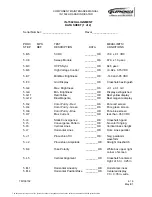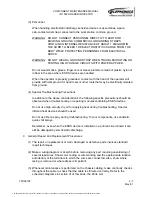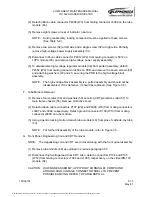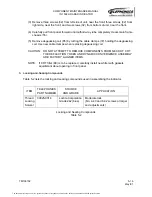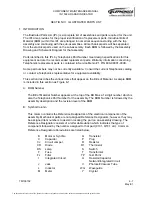
COMPONENT MAINTENANCE MANUAL
IN 1502H RADAR INDICATOR
TM109102
5-5
May/01
4. Repair
WARNING: REMOVE ALL POWER TO THE INDICATOR BEFORE PROCEEDING WITH
REPAIR.
A. Repair Precautions
(1) Refer to paragraph 4.B. for special ESDS handling precautions.
(2) Perform repairs and replace components with power disconnected from the
equipment.
(3) Use a conductive table top for repairs and connect the table to the ground connector
of the 60Hz power line.
(4) Replace any connectors, coaxial cable, shielded conductors and twisted pairs only
with identical items.
(5) When repairing circuits, carefully observe lead dress and component orientation.
Keep leads as short as possible and observe correct repair techniques.
(6) Observe cable routing throughout the indicator prior to disassembly, to enable a
proper reinstallation of the cabling during reassembly.
B. Electrostatic Discharge Sensitive (ESDS) Devices
Devices sensitive to electrostatic discharge are used in this equipment. These devices,
including Metal Oxide Semiconductors, some metal film resistors and other devices, are
susceptible to damage by electrostatic charges or high-voltage fields. Because of the very
high resistances in ESDS devices, they can be damaged by electrical sources that cannot
deliver enough current to damage conventional semiconductors. Therefore, special
precautions must be taken during handling and repair procedures to prevent damaging
the device. The most common low-energy source causing damage to ESDS devices is
the human body, which generates and retains static electricity in conjunction with
non-conductive garments and floor covering. An individual can easily develop several
thousand volts of electrostatic charge while simply walking across the floor or moving
around in a chair. Electrostatic charges of 20kv have been measured on personnel and
35kv has been measured on their garments.
The capacitive elements in all MOS devices can be destroyed by a voltage field, even
when assembled into the circuit. Similar capacitive elements in linear integrated circuits,
hybrids and in bipolar integrated circuits are also susceptible to field voltages.
Not all electrostatic damage will result in immediate catastrophic failure. Damaged
devices may remain operating within the minimum limits but could experience early field
failure or erratic performance.
The following precautions are recommended for ESDS circuits and are especially
important in low humidity or dry conditions when electrostatic problems are more
prevalent.
The document reference is online, please check the correspondence between the online documentation and the printed version.








